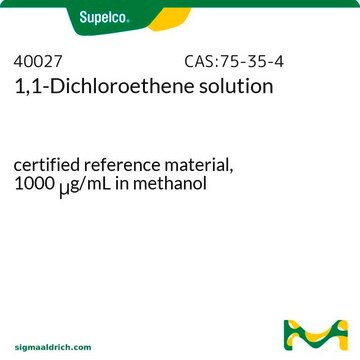おすすめの製品
蒸気密度
3.46 (vs air)
蒸気圧
9.68 psi ( 20 °C)
アッセイ
99%
形状
liquid
自己発火温度
968 °F
含みます
200 ppm MEHQ as inhibitor
expl. lim.
15.5 %
bp
30-32 °C (lit.)
mp
−122 °C (lit.)
密度
1.213 g/mL at 20 °C (lit.)
保管温度
2-8°C
SMILES記法
ClC(Cl)=C
InChI
1S/C2H2Cl2/c1-2(3)4/h1H2
InChI Key
LGXVIGDEPROXKC-UHFFFAOYSA-N
類似した製品をお探しですか? 訪問 製品比較ガイド
アプリケーション
シグナルワード
Danger
危険有害性の分類
Acute Tox. 3 Oral - Acute Tox. 4 Inhalation - Carc. 2 - Eye Irrit. 2 - Flam. Liq. 1 - Skin Irrit. 2
保管分類コード
3 - Flammable liquids
WGK
WGK 3
引火点(°F)
-2.2 °F
引火点(℃)
-19 °C
個人用保護具 (PPE)
Eyeshields, Faceshields, Gloves
適用法令
試験研究用途を考慮した関連法令を主に挙げております。化学物質以外については、一部の情報のみ提供しています。 製品を安全かつ合法的に使用することは、使用者の義務です。最新情報により修正される場合があります。WEBの反映には時間を要することがあるため、適宜SDSをご参照ください。
PRTR
第一種指定化学物質
消防法
第4類:引火性液体
特殊引火物
危険等級I
労働安全衛生法名称等を表示すべき危険物及び有害物
名称等を表示すべき危険物及び有害物
労働安全衛生法名称等を通知すべき危険物及び有害物
名称等を通知すべき危険物及び有害物
Jan Code
163023-100G:
163023-100ML:4548173954448
163023-BULK:
163023-500ML:4548173954455
163023-4X1L:
163023-226.8KG-P1:
163023-25ML:
163023-500G:
163023-199.8KG-P1:
163023-2.5L:
163023-VAR:
163023-1L:
この製品を見ている人はこちらもチェック
ライフサイエンス、有機合成、材料科学、クロマトグラフィー、分析など、あらゆる分野の研究に経験のあるメンバーがおります。.
製品に関するお問い合わせはこちら(テクニカルサービス)












